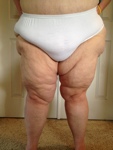Tags
Biacare, CDT, compression, Dercum's Disease, healthcare, Jobst, lipedema, lymphedema, MLD, RAD, rare disease, Wright and Fillippis
Last Tuesday Lee and I drove to Wright and Filippis again to meet with Nora, and this time with the representative from Jobst for another fitting.
And once again I had to spend 5 minutes arguing with a non-medical professional about the prescription my doctor has written.
It’s getting a little tiring.
The rep from Jobst was quite agitated, and said this is so backward, did your doctor tell you that? This is not the way it’s done.
I said after nearly 3 years of trying to get compression, this is the way my doctor has decided it needs to be done. That’s why she wrote the prescription that way.
She said again “but it’s completely backwards, you’re supposed to get MLD first and get compression when you are at maintenance”.
I said that’s not actually correct. We are getting Biacare’s adjustable compression for just that reason. We’re getting your shorts because nobody makes an adjustable short. I wish they would, but they don’t. So we are going to have to work with what we have to work with.
She said well you’re just going to shrink and it won’t fit anymore.
I said that’s the plan. But nobody makes an adjustible short.
She said well nither Jobst nor Wright and Filippis are going to adjust the garment when it doesn’t fit anymore.
I said correct. The insurance company will have to pay for a new one. On the upside, them having to pay for a new one means the treatment is working. Bonus!
She said but doesn’t you’re doctor know…
I cut her off and said look, we have been through this for nearly three years. We’ve been to three different practitioners for MLD. Every single time, they want to treat me three times a week for weeks on end, and hem and haw over ordering the compression even though the standard of care is MLD plus compression. When we insist (because you know, the prescription for MLD also includes the prescription for compression) they talk about ordering for one limb to see how it goes. We know how it goes. I shrink. Fast. And I have a systemic disease. Treating one limb doesn’t move fluid out, it moves fluid around. As I’ve told you several times, my doctor has been helping me on this journey for several years, and we have come to the conclusion the only way to get my systemic disease treated in a systemic manner is for her to order my compression and then start MLD.
I didn’t mention (again) that the standard of care is MLD plus compression, and that MLD without compression is useless.
She just stared at me and said well why won’t the therapists order compression?
I said I’m not sure, but given how many providers I found who either aren’t selling custom compression anymore due to the ridiculously low reimbursement rates or who want me to sign a waver to pay the out of network price even though they are in network, I can only imagine it’s because they lose money on ordering custom compression and they want to make money on providing the MLD first to recoup the money they lose on the compression.
She just stared at me.
Finally she says okay, let’s go ahead and measure you.
It didn’t take a whole lot of time to measure, other than some back and forth about what product line to use.
When we were done Nora informed us that we got the approval for the custom garments, and that the rep from Biacare would have to come measure me again, because custom measurements are more involved. So we have another appointment on Wednesday to be measured for legs, chest and arms. Again.
That makes 4 trips now to Wright and Filippis. More than 70 miles. Each way.
God knows how many more for fitting appointments before I have my garments.
It will all be worth it if I actually get my garments.
Let’s hope.
Until then, be well, my spoonies.

